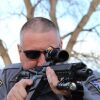Choosing a rifle scope can be a dizzying experience for the uninitiated. Among the many features from which you must choose when purchasing a long-range rifle scope is the reticle. There are dozens of variations of each, but most police sniper rifle optics use either duplex, mil-dot, MOA lines or grid reticles. As with any purchase, you must have a clear-cut goal: What is the purpose for the rifle and optic? In law enforcement, the mission is pretty specific.
Adjustments
We can’t talk about reticles without addressing MOA and mils.
A quality rifle optic generally adjusts the point of aim/point of impact by either minute of angle (MOA) or milliradians (mils). (Contrary to popular belief, the “mil” in mil-dot does not stand for “military.”)
Both MOA and mils are units of angular measurement. Many instructors use the English versus metric systems as an analogy for the relationship between MOA and Mils. They both work; they’re just different.
For example, one MOA at 100 yards is about one inch or 27.5 to 29.1 millimeters (notice I said “about” for all the purists out there). One mil at 100 yards is about 3.6 inches or 10 centimeters at 100 meters.
Though I can’t fathom why, there are still scopes out there with mil reticles and MOA turret adjustments and vice versa. It’s best to avoid that kind of confusing setup. Pick one and stick with it for the sake of repeatability of performance.
Duplex
The duplex reticle is among the simplest. The duplex is nothing more than a slightly upgraded version of traditional cross hairs. The lines of a duplex are thicker on the outside and very thin toward the center so as not to obscure the target. They are quick to the target since the sight picture isn’t as “busy” as with the more complicated setups addressed below.
The downside of the duplex system is that it offers little information to the shooter for estimating range or assisting with quick adjustments and is becoming less commonly used in law enforcement as a result.
MOA and Mils
MOA and Mil scopes can be used to compensate for different ranges and also to roughly gauge distance when time does not permit a more precise means of measurement.
One method of measuring distance with MOA or Mil scopes is using known objects such as traffic signs as a reference to the size of the reticle’s dot or distance between lines. This allows the shooter to estimate the range of the target with a simple triangulation formula. A solid training program is recommended to perfect this technique.
Grid reticles are most commonly offered in Mils in my experience, and can gauge range as mentioned above but can also be used to estimate windage. Grid reticles are generally more expensive, but can be very much worth their cost after a shooter becomes familiar with the system.
Illuminated Reticles
On occasion, some manufacturers offer the option of an illuminated reticle. The need for this feature is pretty rare since most law enforcement sniper deployments happen in well-lit residential areas even in the hours of darkness. Still, when it’s needed, it’s essential. As a side note, police snipers should train with all of their scope’s features in low light regularly to become and stay familiar with their equipment’s capabilities.
Conclusion
Whichever reticle you choose, remember the mission of the rifle/optic combination and choose the equipment vendor as carefully as you choose the brand. Consult the company’s website or speak to someone in sales. A quality optics company or retailer has knowledgeable staff that wants you to make the best choice for your needs and will be anxious to help you do so.




